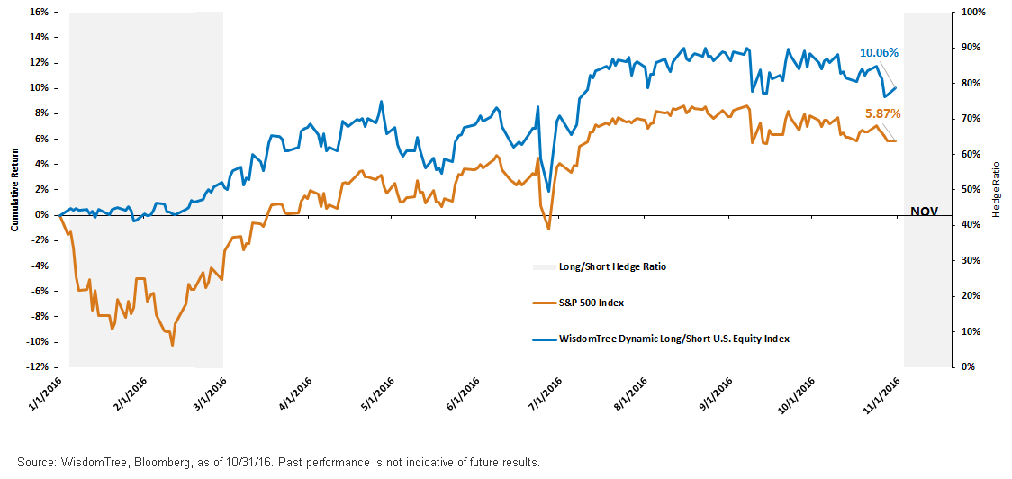Why Five of Six Possible Election Outcomes Could Be Bad for Stocks


Who will win Tuesday night, how will the market react Wednesday and what, if anything, should investors do about it? Before offering a suggestion, let me review why five of six possible election outcomes would likely cause stocks to sell off between now and the end of the year.
Although I believe the race remains too close to call, betting odds through late last week still suggested the more probable outcome was that Hillary Clinton would win and that the House would stay in Republican hands. This is, I believe, the only scenario in which stocks rally between now and the end of the year. Put another way, a President-elect Clinton could provide some post-election relief coupled with expectations that not much will change in a gridlocked Washington. That “all-clear” signal would encourage both U.S. and foreign investors to put money back to work and allow the focus to return to the Fed, the economy and corporate fundamentals.
But there are five other possible election outcomes that I believe would likely send stocks even lower over the next seven weeks.
1. Hillary Clinton wins and the Democrats win the House and the Senate. This is a low-probability event, but if it happened, the potential for higher taxes, more regulation and a complete government takeover of the health care industry become much more likely.
2. Donald Trump wins. The market began to discount this last week, but an actual Trump victory is not fully priced in. Foreign investors will likely view a Trump victory as an unsettling global event, one that could potentially undermine global trade and U.S. leadership in the world. Actual or threatened tariffs could have implications for U.S. multinationals and for the stocks of companies throughout emerging and developed markets that sell into the U.S.
3. Donald Trump wins and the Democrats win the House or the Senate. I believe this would be an even worse outcome for the U.S. market because it could dramatically reduce the chance for any meaningful tax reform in the next two years—one potential upside of a Trump presidency. The nation would be subjected to the uncertainty of Donald Trump running America’s foreign policy, with near certainty that Congress would not pass his sweeping tax cuts or reforms to reignite economic growth at home.
4. We get a contested election. If the race is close and one of the candidates contests the results, there may be no definitive victor come Wednesday morning. If that happens, you get an extension of the partisan drama (and the accompanying cable TV coverage) through the fall, which means continued uncertainty and likely lower stock prices. The last time that happened, during the Bush vs. Gore tribulations of 2000, the S&P 500 Index sold off nearly 8% from election night through the end of the year. But unlike 2000, only eight justices today sit on the Supreme Court. So if the election needs to be adjudicated, the possibility of a deadlocked Supreme Court adds one more piece to an uncertain puzzle.
5. Neither Donald Trump nor Hillary Clinton emerges with 270 electoral votes on Tuesday night. There are many computations that generate a 269 to 269 tie in electoral votes. If neither Clinton nor Trump secures an Electoral College majority, the Constitution dictates that the next House of Representatives (sworn in on January 3, 2017) must choose the next president from the top three presidential candidates with the most electoral votes. Each state’s congressional delegation gets one vote. That means, in all likelihood, House Republicans would control this process and choose Trump over Clinton. Put another way, as a practical matter, if the Republicans hold the House, the magic number for Donald Trump is 269 electoral votes, not 270. But before the House meets in January, members of the Electoral College must first meet on December 19th to cast their electoral votes. It’s not an official tie until this final check and balance built into the Constitution by the founders actually happens. For example, if one elector from a state that Trump won overrules the will of the people and casts a vote for Clinton, the decision would never get to the House. Only about half the states have laws compelling electors to vote for the party candidate chosen by the people in that state. States that have no such laws include Utah and Texas- states that Trump lost in the Republican primaries and whose party establishments have ties to prominent Republicans that have failed to endorse Trump (Mitt Romney in Utah and former presidents George W. Bush and George H.W. Bush in Texas). This last scenario takes us through the looking glass and down a rabbit hole, but it is not an impossible scenario because a remnant of the “Never Trump” contingent within the Republican Party may choose to play its lone, remaining trump card if provided the opportunity. All it would take is one party elder to shift one vote to deny Trump the White House and swing the election to Clinton.
You got all that?
Hedging the Equity Market
So how can investors “hedge” some of the potential downside in the next few weeks? One way is to incorporate a long/short strategy into one’s equity allocation.
WisdomTree created an exchange-traded fund (ETF) late last year that is designed to do this. It tracks the WisdomTree Dynamic Long/Short U.S. Equity Index, which modifies its equity exposure between 100% long, 50% long, and 0% net long, depending on the overall market environment. For the first time since early this year, the market environment has turned bearish, and thus the ETF that tracks the WisdomTree Index, the WisdomTree Dynamic Long/Short U.S. Equity Fund (DYLS), is now effectively market neutral. Below, we show how that hedging signal has helped the WisdomTree Dynamic Long/Short U.S. Equity Index outperform the S&P 500 by more than 400 basis points (bps) year-to-date. (The gray bar below denotes the periods when the Index’s “hedging indicator” directed the Index to assume a 0% net long position).
WisdomTree Dynamic Long/Short U.S. Equity Index and the S&P 500 Index Year-to-Date Cumulative Total Return (12/31/15–10/31/16)

Click here to view the standardized performance for DYLS.
The hedging indicator within the WisdomTree methodology incorporates two fundamental drivers of quality and value to derive a “market signal.” The value portion of this indicator did not change since September and still posts a “mixed reading.” However, the quality or growth indicator derived from trends in operation margins (operating income divided by sales), net margins (net income dividend by sales) and ratios of operating cash flow to operating income moved from positive in September to negative for the month of November. The deterioration in fundamentals was great enough to generate a 0% net equity exposure signal.
Conclusion
For investors looking to dampen volatility and the impact of a potential market correction, consider DYLS. The short component of its underlying long/short Index, which is evaluated monthly, has been activated for the month of November.
Important Risks Related to this Article
There are risks associated with investing, including possible loss of principal. The Fund invests in derivatives, including as a substitute to gain short exposure to equity securities. Derivative investments can be volatile, and these investments may be less liquid than other securities, and more sensitive to the effects of varied economic conditions. Derivatives used by the Fund to offset its exposure to market volatility may not perform as intended. The Fund may engage in “short sale” transactions and will lose value if the security or instrument that is the subject of a short sale increases in value. A Fund that has exposure to one or more sectors may increase the Fund’s vulnerability to any single economic or regulatory development. This may result in greater share price volatility. The composition of the Index is heavily dependent on quantitative models and data from one or more third parties, and the Index may not perform as intended. The Fund invests in the securities included in, or representative of, its Index regardless of their investment merit, and the Fund does not attempt to outperform its Index or take defensive positions in declining markets. Please read the Fund’s prospectus for specific details regarding the Fund’s risk profile.Performance is historical and does not guarantee future results. Current performance may be lower or higher than quoted. Investment returns and principal value of an investment will fluctuate so that an investor’s shares, when redeemed, may be worth more or less than their original cost. Performance data for the most recent month-end is available at www.wisdomtree.com.
WisdomTree shares are bought and sold at market price (not NAV) and are not individually redeemed from the Fund. Total returns are calculated using the daily 4:00 p.m. EST net asset value (NAV). Market price returns reflect the midpoint of the bid/ask spread as of the close of trading on the exchange where Fund shares are listed. Market price returns do not represent the returns you would receive if you traded shares at other times.


